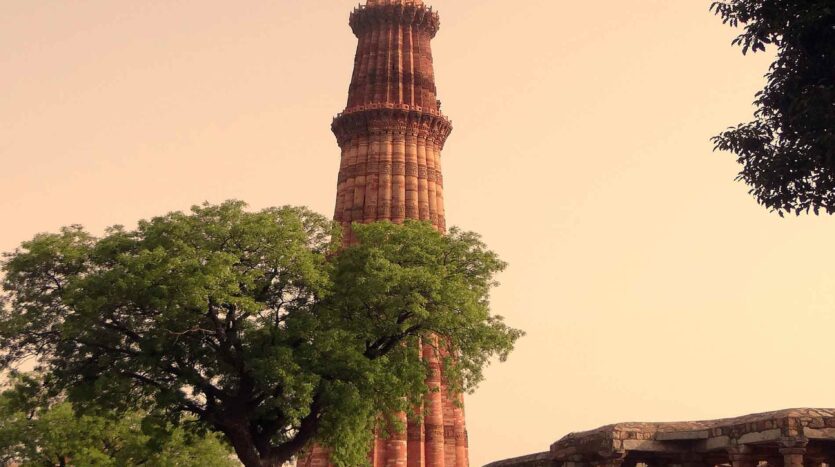Qutub Minar
Introduction to Qutub Minar: A Brief History and Overview
Qutub Minar is a UNESCO World Heritage Site located in Delhi, India. It is a towering minaret that stands 72.5 meters tall and is made of red sandstone and marble. The construction of Qutub Minar began in the 12th century by Qutub-ud-din Aibak, the first ruler of the Delhi Sultanate, and was completed by his successor, Iltutmish. The minaret is a stunning example of Indo-Islamic architecture and is considered one of the most significant historical monuments in India.
The Architecture and Design of Qutub Minar: Exploring its Intricate Features
Qutub Minar is a remarkable feat of engineering and architecture. The minaret is composed of five stories, each with a projecting balcony. The first three stories are made of red sandstone, while the upper two stories are made of marble. The intricate carvings and calligraphy on the minaret’s surface reflect the cultural and artistic influences of the time, with a blend of Hindu, Islamic, and Persian styles.
The minaret’s base is surrounded by several other important structures, including the Quwwat-ul-Islam Mosque, one of the oldest mosques in India, and the Iron Pillar of Delhi, a 7-meter-tall iron pillar that has stood for over 1,500 years without rusting or corroding. These structures provide important insights into the cultural and religious history of Delhi and India.
The Different Sections of Qutub Minar: A Guide to its Main Attractions
Qutub Minar has several main attractions that visitors should not miss. The first is the minaret itself, which offers stunning views of Delhi from the top. Visitors can climb the 379 steps to the top, but should be aware that the staircase can be narrow and steep, and the top can get quite crowded.
The Quwwat-ul-Islam Mosque is another notable attraction at Qutub Minar. The mosque is one of the oldest surviving examples of mosque architecture in India and is known for its impressive architectural features, including the carved sandstone pillars and arched gateways. Visitors can also explore the nearby ruins of other ancient structures, including the Alai Darwaza, a gateway built by Sultan Alauddin Khilji.
Qutub Minar’s Role in India’s History: From Delhi Sultanate to Modern Times
Qutub Minar has played an important role in India’s history. It was built during the Delhi Sultanate period, which lasted from the 12th to the 16th century and saw the rise of several powerful dynasties in North India. The minaret’s construction was a reflection of the Sultanate’s wealth and power and was intended to symbolize the triumph of Islam over Hinduism.
Over the centuries, Qutub Minar has survived several periods of political instability and invasion, including the British Raj. Today, it is a symbol of India’s rich cultural heritage and is an important tourist attraction and pilgrimage site.
Restoration and Preservation Efforts at Qutub Minar: Ensuring its Protection and Longevity
In recent years, Qutub Minar has undergone several restoration and preservation projects to ensure its protection and longevity. The government has implemented several measures to prevent damage from pollution and overcrowding, including restricting the number of visitors and regulating the use of nearby buildings. The government has also undertaken several conservation projects to restore and preserve the minaret’s intricate carvings and calligraphy.
Tips for Visitors to Qutub Minar: What to Expect and How to Plan Your Visit
-
Plan Your Visit in Advance: Qutub Minar can get quite crowded, particularly during peak season, so it’s a good idea to plan your visit in advance. Consider visiting during the cooler months, from October to March, to avoid the heat and humidity.
- Wear Comfortable Clothing and Footwear: Visitors should wear comfortable clothing and footwear, as they will be doing a lot of walking and climbing. It’s also a good idea to bring a hat, sunscreen, and water, as the sun can be intense.
- Be Prepared For Security Checks: Qutub Minar is a high-security area, and visitors will need to go through metal detectors and have their bags checked before entering. Make sure to carry only essential items and leave any prohibited items, such as knives or scissors, at home.
- Hire a Guide or Audio Guide: To get the most out of your visit, consider hiring a guide or renting an audio guide. They can provide valuable insights into the history and architecture of Qutub Minar and its surrounding structures.
- Respect Local Customs And Traditions: Qutub Minar is a religious site, and visitors should dress modestly and behave respectfully. Avoid loud conversations, smoking, and littering, and follow the instructions of security personnel.
-
Be Mindful of Your Surroundings: Qutub Minar is a busy and bustling place, and visitors should be mindful of their surroundings. Watch out for pickpockets and keep an eye on your belongings at all times.
Entry Fee
The entry fee for Qutub Minar varies for Indian and foreign visitors. The fee for Indian visitors is INR 40 per person, while foreign visitors are charged INR 550 per person. However, children below the age of 15 years are exempted from the entry fee.
It’s important to note that the entry fee and other fees are subject to change, so it’s always a good idea to check the official website or inquire locally before visiting Qutub Minar.


